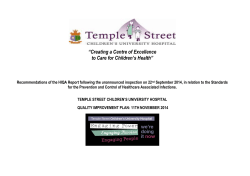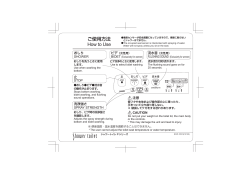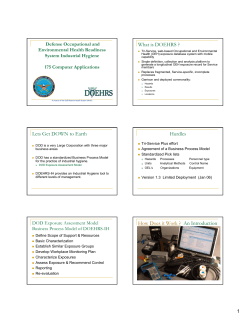
Hand washing and hand disinfection
Anesthesiology Clin N Am 22 (2004) 457 – 471 Hand washing and hand disinfection: more than your mother taught you Jonathan D. Katz, MDa,b,* a b Yale University School of Medicine, 333 Cedar Street, New Haven, CT 06520, USA Department of Anesthesiology, St. Vincent Medical Center, Bridgeport, CT 06606, USA And Aaron and his sons shall wash their hands. . .that they die not. Exodus 30 The importance of thorough hand washing for protection against various forms of communicable disease has been known since early recorded history. Its significance for the practice of medicine, however, was not generally appreciated until the pioneering works of Oliver Wendell Holmes (1843) [1] and Ignaz Phillip Semmelweiss (1846) [2], who independently recognized the role of contagions on the hands of doctors in the spread of puerperal fever, and Joseph Lister [3], who identified the importance of antisepsis in the practice of surgery. Thirty years later, largely through the work of William Halstead and others at Johns Hopkins University, the use of rubber gloves during surgery became routine practice, and the era of aseptic surgery was introduced. The scientific basis for the practices of hand hygiene (see Box 1) did not emerge until the introduction of the germ theory of disease by Louis Pasteur [4] and the delineation of the relationship between a specific microorganism (Bacillus anthracis) and its resultant disease (anthrax) by Robert Koch [5]. Skin Human skin is composed of four distinct layers, each performing a specific physiologic function. The outermost layer, the stratum corneum, is composed of a tough horny layer of keratin bound together by a number of different skin lipids. This layer of skin serves as the primary permeable barrier against water loss from the body and penetration of water and other chemicals into the system. * Department of Anesthesiology Yale University School of Medicine, 333 Cedar Street, New Haven, CT 06520. E-mail address: jonathan.katz@yale.edu 0889-8537/04/$ – see front matter D 2004 Elsevier Inc. All rights reserved. doi:10.1016/j.atc.2004.04.002 458 J.D. Katz / Anesthesiology Clin N Am 22 (2004) 457–471 Box 1. Indications for hand washing and hand antisepsisa ‘‘Hand washing’’ is defined as a process for removal of soil and transient microorganisms from the hands. Hands should be washed with soap and water or disinfected: 1. When hands are visibly dirty or contaminated with proteinaceous material or are visibly soiled with blood or other body fluids, wash hands with either a non-antimicrobial soap and water or an antimicrobial soap and water. 2. If hands are not visibly soiled, use an alcohol-based hand rub for routinely decontaminating hands in all other clinical situations described in items 3– 10 below. Alternatively, wash hands with an antimicrobial soap and water in all clinical situations described in items 3– 10 below. 3. Decontaminate hands before having direct contact with patients. 4. Decontaminate hands before donning sterile gloves when inserting a central intravascular catheter. 5. Decontaminate hands before inserting indwelling urinary catheters, peripheral vascular catheters, or other invasive devices that do not require a surgical procedure. 6. Decontaminate hands after contact with a patient’s intact skin (eg, when taking a pulse or blood pressure and lifting a patient). 7. Decontaminate hands after contact with body fluids or excretions, mucous membranes, non-intact skin, and wound dressings if hands are not visibly soiled. 8. Decontaminate hands if moving from a contaminated body site to a clean body site during patient care. Decontaminate hands after contact with inanimate objects (including medical equipment) in the immediate vicinity of the patient. 9. Decontaminate hands after removing gloves. 10. Before eating and after using a restroom, wash hands with a non-antimicrobial soap and water or with an antimicrobial soap and water. 11. Antimicrobial-impregnated wipes (ie, towelettes) may be considered as an alternative to washing hands with non-antimicrobial soap and water. Because they are not as effective as alcohol-based hand rubs or washing hands with an antimicrobial soap and water for reducing bacterial counts on the hands of HCWs, they are not a substitute for using an alcohol-based hand rub or antimicrobial soap. J.D. Katz / Anesthesiology Clin N Am 22 (2004) 457–471 459 12. Wash hands with non-antimicrobial soap and water or with antimicrobial soap and water if exposure to Bacillus anthracis is suspected or proven. The physical action of washing and rinsing hands under such circumstances is recommended because alcohols, chlorhexidine, iodophors, and other antiseptic agents have poor activity against spores. a Data from Boyce JM, Pittet D. Guideline for hand hygiene in health-care settings. recommendations of the Healthcare Infection Control Practices Advisory Committee and the HICPAC/SHEA/ APIC/IDSA Hand Hygiene Task Force. Society for Healthcare Epidemiology of America/Association for Professionals in Infection Control/Infectious Diseases Society of America. MMWR 2002;51: 1– 45. Deep to the stratum corneum is the epidermis. The epidermis is a metabolically active, stratified squamous, cornifying epithelium that is populated by keratinocytes (synthesis of keratin), melanocytes (skin pigmentation), Langerhans cells (antigen identification and immune response), and Merkel cells (lowthreshold touch receptors). Deep to the epidermis is the dermis. The dermis is composed largely of noncellular connective tissue in which is imbedded nerves, blood and lymphatic vessels, muscle tissue, and follicular, sebaceous, apocrine, and endocrine units. The hypodermis is the layer of subcutaneous fat that lies deep to the true skin elements described above. Human skin is normally colonized with a bacterial flora. The microbial composition and count of the skin flora vary depending on gender, age, health condition, and location on the body. Bacteria found on the hands reside in highest concentrations in the subungual area and are divided into three categories: resident flora (permanently reside in the stratum corneum), transient flora (occur as skin contaminants), and infectious flora (the causal agents of hand infections). The resident flora on the hands are composed of a large number of microbial species, including the gram-positive Micrococcaceae (Staphylococcus epidermidis, S. hominis, and S. captitis), Corynebacterium (Corynebacterium jeikeium), and Propionibacterium (Propionibacterium acnes and P. granulosum). S. aureus is frequently present, especially among health care workers (HCWs) [6]. Gramnegative organisms such as Acinetobacter and members of the Klebsiella genus of the Enterobacteriaceae family also frequently reside on the hands of HCWs. The resident flora are relatively resistant to removal by hand washing and contribute to resistance against colonization by other, potentially pathogenic microorganisms. The transient flora occur as contaminants on the more superficial layers of the skin and are characterized by their inability to reproduce on the skin. Compared 460 J.D. Katz / Anesthesiology Clin N Am 22 (2004) 457–471 with the resident flora, the transient flora colonize more readily with pathogenic organisms, are most frequently associated with health care-associated infections, and are most susceptible to hand washing. The infectious flora are the causal agents of such hand infections as abscesses and paronychia. The commonest pathogenic organisms found on the hands are S. aureus and various streptococci. Protocols for hand disinfection Protocols for the prevention of hand-associated microbial transfer include the use of surgical gloves, the proper use of instruments to replace direct hand contact, and hand hygiene protocols. Hand hygiene practices include the standard hand wash (soap and water), the hygienic hand wash (medicated soap), the hygienic hand rub (fast-acting antiseptic solutions), and the surgical hand scrub. Recommendations for hand hygiene practices in hospitals have been issued by a number of professional organizations, including the American Society of Anesthesiologists [7]. Formal written protocols have been published by the Centers for Disease Control and Prevention (CDC) (1975 [8] and 1985 [9]) and the Association for Professionals in Infection Control and Epidemiology (AIPC) (1988 [10] and 1995 [11]). Guidelines have also been published by the Health care Infection Control Practices Advisory Committee (HICPAC) (1995 [12] and 1996 [13]) and the Association of Operating Room Nurses (AORN) (1997 [14] and 1999 [15]). In 2002, the CDC consolidated and updated these documents with its ‘‘Guidelines for Hand Hygiene in Health care Settings: Recommendations of the Health care Infection Control Practices Advisory Committee and the HICPAC/SHEA/APIC/IDSA Hand Hygiene Task Force’’ (www.cdc.gov/mmwr/preview/mmwrhtml/rr5116a1.htm) [16]. These guidelines are a comprehensive document that provides a thorough analysis of the science of hand hygiene, with specific recommendations for the why’s and how’s of hand hygiene practices in the modern health care settings (Boxes 1 – 3). One important innovation found in the new CDC guideline, with implications for the practicing anesthesiologist, is the recommendation that alcohol-based hand rubs be readily available and, in many cases, can be substituted for a traditional hand washing with soap and water. This is particularly useful in an operating room where the anesthesiologist is unable to leave the patient’s bedside to go to a scrub sink before or after a procedure, such as line placement. Hand hygiene products Soap Soaps are detergent-based products that rely on their detergent properties to provide cleansing functions. Unless antiseptics are added, plain soaps provide minimal antimicrobial activity. Frequent hand washing with plain soap can cause dryness and irritation and, paradoxically, increases in bacterial counts [17]. J.D. Katz / Anesthesiology Clin N Am 22 (2004) 457–471 461 Box 2. Recommended hand hygiene techniquea ‘‘Hand hygiene’’ is an inclusive term that includes washing with soap and water and/ or performing antisepsis with a waterless antiseptic agent. 1. When decontaminating hands with an alcohol-based hand rub, apply product to palm of one hand and rub hands together, covering all surfaces of hands and fingers, until hands are dry. Follow the manufacturer’s recommendations regarding the volume of product to use. 2. When washing hands with soap and water, wet hands first with water, apply an amount of product recommended by the manufacturer to hands and rub hands together vigorously for at least 15 seconds, covering all surfaces of the hands and fingers. Rinse hands with water and dry thoroughly with a disposable towel. Use towel to turn off the faucet. Avoid using hot water, because repeated exposure to hot water may increase the risk of dermatitis. 3. Liquid, bar, leaflet, or powdered forms of plain soap are acceptable when washing hands with a non-antimicrobial soap and water. When bar soap is used, soap racks that facilitate drainage and small bars of soap should be used. 4. Multiple-use cloth towels of the hanging or roll type are not recommended for use in health-care settings. a Data from Boyce JM, Pittet D. Guideline for hand hygiene in health-care settings. recommendations of the Healthcare Infection Control Practices Advisory Committee and the HICPAC/SHEA/ APIC/IDSA Hand Hygiene Task Force. Society for Healthcare Epidemiology of America/Association for Professionals in Infection Control/Infectious Diseases Society of America. MMWR 2002;51: 1– 45. Alcohols Alcohol antiseptics contain isopropanol, n-propanol, or ethanol. Alcohols produce their antimicrobial action primarily by denaturing proteins. In concentrations of 60% to 95% by weight, alcohol antiseptics provide excellent antibacterial, antifungal, and antiviral activities and rapid and persistent reductions in microbial counts on skin [18]. In many commercial preparations, additional chemicals, such as hydrogen peroxide or iodine, are added to enhance antiviral or sporicidal activity. Alcohol-based hand rubs are now available as 462 J.D. Katz / Anesthesiology Clin N Am 22 (2004) 457–471 Box 3. Surgical hand antisepsisa 1. Remove rings, watches, and bracelets before beginning the ‘‘surgical hand scrub’’ (ie, a process to remove or destroy transient microorganisms and reduce resident flora. 2. Remove debris from underneath fingernails using a nail cleaner under running water. 3. ‘‘Surgical hand antisepsis’’ (ie, a process for removal or destruction of transient microorganisms) using either an antimicrobial soap or an alcohol-based hand rub with persistent activity is recommended before donning sterile gloves when performing surgical procedures. 4. When performing surgical hand antisepsis using an antimicrobial soap, scrub hands and forearms for the length of time recommended by the manufacturer, usually 2 – 6 minutes. Long scrub times (eg, 10 minutes) are not necessary. 5. When using an alcohol-based surgical hand-scrub product with persistent activity, follow the manufacturer’s instructions. Before applying the alcohol solution, prewash hands and forearms with a non-antimicrobial soap and dry hands and forearms completely. After application of the alcoholbased product as recommended, allow hands and forearms to dry thoroughly before donning sterile gloves. a Data from Boyce JM, Pittet D. Guideline for hand hygiene in health-care settings. recommendations of the Healthcare Infection Control Practices Advisory Committee and the HICPAC/SHEA/ APIC/IDSA Hand Hygiene Task Force. Society for Healthcare Epidemiology of America/Association for Professionals in Infection Control/Infectious Diseases Society of America. MMWR 2002;51: 1 –45. rinses, gels, and foams. The major disadvantage of alcohol-based antisepsis is the drying effect on the skin. Commercially prepared products frequently include emollients, humectants, and other skin-conditioning agents to minimize the drying effect of the alcohol. Chlorhexidine Chlorhexidine gluconate produces its antimicrobial activity by increasing the permeability of the microbial cell, disrupting cytoplasmic membranes, and precipitating cell contents. A major disadvantage of chlorhexidine gluconate is its slow onset and relatively narrow range of antimicrobial activity. Its major advantage is its superior residual activity. It is most commonly used in com- J.D. Katz / Anesthesiology Clin N Am 22 (2004) 457–471 463 bination with other hand hygiene products. Chlorhexidine gluconate is associated with a relatively low incidence of skin irritation but has been reported to cause isolated cases of contact dermatitis and anaphylactic allergic reactions [19]. Chloroxylenol Chloroxylenol, also known as parachlorometaxylenol, derives its antimicrobial action by deactivating bacterial enzymes. Most commonly used as an antimicrobial agent in soaps, parachlorometaxylenol does not consistently demonstrate a broad spectrum of antimicrobial effectiveness or residual activity as compared with many of the other commercially available antiseptics. Hexachlorophene The antimicrobial activity of hexachlorophene is its ability to inactivate enzyme systems and to disrupt microbial cell walls. Once universally endorsed for hygienic hand washing, it has become less popular in recent years because of its relatively narrow range of antimicrobial action [20] and the demonstration of harmful systemic absorption after extended use [21]. The major advantage of hexachlorophene is its persistent activity [20]. Iodophors Iodophors are complexes composed of iodine and a carrier such as polyvinylpyrrolidone (or povidone). The iodine exerts its antimicrobial action by crossing cell walls and substituting microbial contents with free iodine. Iodophors have a relatively wide range of antimicrobial activity. Problems associated with iodophor use are a relatively high incidence of skin irritation and allergic reactions, and the partial neutralization of activity in the presence of organic materials such as blood or sputum [22]. Quaternary ammonium compounds Members of this large group of complex compounds have been among the earliest antiseptics used routinely for surgical hand scrubs. They act by adsorption onto the cytoplasmic membrane, with subsequent leakage of cytoplasmic contents. These compounds are primarily bacteriostatic and fungistatic and are more active against gram-positive than gram-negative bacteria. Triclosan Triclosan is a diphenyl ether. Its antimicrobial activity results from the entry into the bacterial cell where it impedes the synthesis of RNA and proteins. In common clinical usage, triclosan is more bacteriostatic than bacteriocidal and has limited efficacy against Pseudomonas aeruginosa and most fungi. It is minimally 464 J.D. Katz / Anesthesiology Clin N Am 22 (2004) 457–471 affected by the presence of organic matter or blood and has the advantage of excellent persistent activity. Surgical scrub The surgical hand scrub is a specialized form of hand hygiene, with its own traditions and rituals. First introduced by Semmelweiss, who used chlorinated lime [2], surgical hand scrubbing became a standard practice because of the work of Lister [3], who used carbolic acid to soak his fingers and surgical instruments. The intended goal of the surgical hand scrub is to reduce surgical infections by removing dirt and debris and reducing the resident flora from the hands of the surgical team for the duration of a procedure. An effective surgical scrub should ideally provide the following antimicrobial effects: 1. Immediate reduction in the resident bacterial flora that is associated with surgical site infections 2. Sustained effect to maintain a reduced bacterial count under surgical gloves 3. Cumulative effect, so that each additional application of the antiseptic further reduces the microbial count 4. Persistent effect that results in a progressive reduction of the skin flora with repetitive use of the agent Unfortunately, the precise role of the surgical hand scrub in the incidence of surgical wound infections is unclear [23]. The traditional 10-minute surgical scrub, using a stiff brush and harsh chemicals, does not meet the criteria for satisfactory antimicrobial action (an immediate reduction in microbial count that is sustained, cumulative, and persistent) and is associated with a number of difficulties and problems, chiefly a high incidence of irritation and dermatitis that can paradoxically result in an increased microbial population on the hands of the surgical team [17]. Frequent surgical scrubs also expose HCWs to potential health risks. As many as 85% of HCWs [24], and anesthesiologists [25,26] specifically, have a history of irritant and allergic contact dermatitis attributed to the detergents in hand hygiene products. Frequent scrubbing also results in a reduction in the benign resident flora and an increased vulnerability to contaminating pathogenic microorganisms such as Klebsiella spp and Escherichia coli [6,17,27]. A number of modifications have been made to the traditional surgical hand scrub to enhance its salutary effects and minimize its harmful effects. The duration of recommended scrub time has been decreased so that a 2-minute scrub time is now considered by many to be optimal [23]. Many authors have recommended the complete elimination of the use of a scrub brush, to minimize abrasion of the hands [28,29]. Several new antiseptics, as well as emollients and humectants, have been introduced to minimize the dryness and dermatitis resulting from the surgical hand scrub. Some HCWs have begun to routinely J.D. Katz / Anesthesiology Clin N Am 22 (2004) 457–471 465 apply barrier creams in an attempt to further minimize irritant contact dermatitis, but their effectiveness has been questioned [30], and a potentially harmful role in solubilizing proteins in rubber gloves has been identified [31]. Compliance with hand hygiene standards Unfortunately, HCWs are generally complacent about following even basic hand hygiene practices. As few as 5% [32] and on average 48% [33] of all HCWs comply with the fundamentals of hand hygiene practices. HCWs, on average, wash or disinfect their hands in half the reported instances [33]. Physicians have consistently been shown to be the least compliant of all HCWs studied [33,34]. Hand hygiene practices are particularly lax in intensive care areas of hospitals, including the operating room suites (outside of the surgical field) and before high-risk procedures are performed [35,36]. There have been few reports [37] of hand hygiene practices and infection control specifically among anesthesiologists, but there is apparently no better compliance among anesthesiologists than other intensive care clinicians. For example, a 1995 study [38] of American anesthesiologists reveals that only 58% always washed their hands after contact with patients considered ‘‘low risk’’ for infection with HIV or HBV. In a 1999 report on British anesthesiologists, gloves were always used during anesthetics by 14.5% of the respondents, and only 36.4% washed their hands between cases [39]. In a survey of Australian anesthesiologists, 1% of respondents felt that epidural catheters could safely be placed without wearing sterile gloves [40]. Similarly, hand hygiene practices in post-anesthesia care units (PACUs) are no better in other intensive care settings. Indeed, risk factors associated with the highest rate of noncompliance in intensive care units, such as a heavy workload, a large number of independent contacts between patient and HCW, a high intensity of patient care, an elderly patient population, and the concurrence of a number of patient-care demands, are all experienced as well within operating rooms and PACUs [41]. The open ward architecture of most PACUs also makes it less likely that staff will rigidly adhere to optimal hand hygiene practices. A recent study by Pittet et al [42] examined hand washing practices in a PACU. They observed that the staff’s average compliance with hand hygiene protocols when admitting a new patient to the PACU was 19.6%. Compliance for patients already admitted to the PACU was 12.5%. It is not surprising that there is better compliance when the HCW perceives a significant threat to his/herself [43]. For example, when caring for a PACU patient who has undergone a ‘‘dirty’’ surgical procedure, approximately 95% of the staff washed their hands after contact with a patient thought to be carrying HIV or HBV, compared with only 58% who washed after treating these patients and considered themselves to be free of these viruses [38]. In addition to washing their hands less frequently than is recommended, HCWs frequently do not wash thoroughly (including all surfaces of the hands and 466 J.D. Katz / Anesthesiology Clin N Am 22 (2004) 457–471 fingers) or for an adequate duration [23]. Most protocols recommend a minimum of 30 seconds of hand washing; however, the average time spent in washing by HCWs is less than 10 seconds [44]. A number of factors contribute to this overall dismal rate of compliance with recommended hand hygiene practices. A major contributing factor is a lack of awareness among HCWs of the patient-care activities that require hand washing (see Box 1). For example, it is not generally appreciated that HCWs can contaminate their hands with pathogenic organisms even while performing ‘‘clean’’ activities such as taking a patient’s blood pressure or even touching a patient’s hand [45]. Less well appreciated is how readily communicable diseases can be transmitted simply by contact with inanimate objects in the proximity of infected patients [46]. Also, among HCWs there is a common misconception that wearing gloves and gown serves as a substitute for hand washing [47]. Other important factors contributing to poor hand hygiene practices include the unpredictable and sporadic nature of the workload distribution and various logistical barriers (such as the location of scrub sinks) [48,49]. Overcrowding of patients and understaffing of personnel with a corresponding high workload have both been consistently associated with poor compliance with hand hygiene practices [36,50 –52]. Skin irritation and dryness resulting from frequent hand washing is also commonly cited as a reason for inadequate or infrequent hand washing [49]. Attempts are being made to provide solutions to the problems of inadequate hand hygiene practices. An important first step is the increased availability of antiseptic solutions that cause minimal drying and contain protectants to minimize irritation to the skin of the hand [49]. These products must be readily accessible to HCWs at the patient’s bedside [53]. By replacing the traditional sink-based hand wash with a bedside antiseptic hand rub, HCWs can reduce the time necessary to wash between patient encounters by 75% [54], suffer less skin irritation, experience better antisepsis, and consequently be more inclined to adhere to their hospital’s hand hygiene protocol. Hospitals are also increasing their efforts to monitor compliance and to provide feedback to HCWs on their performance of this procedure [55]. Consequences of poor hand hygiene Nosocomial infections It has been estimated that 1 of every 20 hospitalized patients contracts a nosocomial infection, resulting in 80,000 deaths annually in the United States [56]. The majority of these infections are caused by the transmission of microorganisms on the hands of health care providers who have either not washed their hands or did so inadequately between patients [11,57,58]. Hand washing is the single most important preventative measure to avoid health care provider-topatient transmission of disease [11]. J.D. Katz / Anesthesiology Clin N Am 22 (2004) 457–471 467 Clear evidence exists for the consequences of inadequate hand hygiene. Those factors associated with poor adherence with hand hygiene protocols, such as understaffing, patient overcrowding, and high workload (see above) are also associated with outbreaks of communicable diseases in hospitals [41]. In fact, most nosocomial infections in intensive care units and PACUs are the result of cross-contamination from microorganisms carried on the hands of HCWs [58,59]. A study reported in 1962 by Mortimer et al [60] demonstrated that 92% of infants who were cared for by nurses who did not wash their hands between patients acquired S. aureus from an index infant. Only 53% of infants who were cared for by nurses who did wash their hands acquired the infection. Similarly, inadequate hand washing among hospital staff has been identified as the primary cause of clusters of infection from Klebsiella spp [45], P. aeruginosa [61], and Enterobacter cloaca [41]. Conversely, improvements in hand hygiene practices have a clearly demonstrable positive impact on nosocomial infection rates [62,63]. This was first demonstrated when Semmelweiss showed a reduced rate of mortality among mothers after staff had been instructed to wash their hands with an antiseptic agent between patients [2]. In many cases, the spread of hospital-acquired infections can be limited by the simple act of improving hand washing practices among staff [63,64]. For example, infection by hospital-acquired Klebsiella spp. has been contained by requiring more frequent hand washing among hospital staff [46]. Other health care-associated pathogens, including methicillin-resistant S. aureus have been contained by changing the antiseptic agent used for hand washing [61,65,66]. Risks to HCW Lack of compliance with recommended hand hygiene protocols also places the health care worker in jeopardy of acquiring their patient’s communicable diseases. A broad spectrum of infectious diseases has been transmitted from patient to health care provider as a result of contact exposure. Infections and organisms that carry a particularly high risk of transmission include chickenpox, conjunctivitis, influenza, measles, mumps, human paravirus B19, pertussis, respiratory syncytial virus, rotavirus, rubella, S. aureus, Streptococcus, and tuberculosis. Conjunctivitis is a good example of a disease that is relatively uncommon in the general adult population but is frequently seen among HCWs and is avoidable with proper attention to hand hygiene. Most health care-associated epidemics of conjunctivitis are caused by an adenovirus that is contracted after contact with an inanimate reservoir (such as a linen roll towel dispenser) or a person harboring the virus. The most efficient way to interrupt transmission of conjunctivitis is to identify and isolate the source and to impose strict hand washing standards [67,68]. In addition to facilitating the direct transmission of disease, inadequate hand hygiene can promote a transition to a more pathogenic residual flora among HCWs. For example, before the routine use of gloves for most patient contact activities, as many as 30% of nurses were shown to harbor significant counts of 468 J.D. Katz / Anesthesiology Clin N Am 22 (2004) 457–471 S. aureus and gram-negative bacilli on their hands [18]. S. aureus was cultured in 78% of nurses who worked exclusively with dermatology patients. More recently, well into the era of Universal Precautions, pathogenic organisms were cultured from the hands of 19% of hospital staff [55]. Summary Hand washing is considered the single most important intervention for prevention of nosocomial infections in patients and health care workers. Unfortunately, compliance with standard protocols for hand hygiene in the health care environment has been generally poor. This is especially true in intensive care areas such as operating rooms and post-anesthesia care units. Procedures and products used for hand washing have undergone significant improvements in the most recent decade. Most of these changes were implemented specifically with the goal of improving compliance with hand hygiene practices. Recent modifications have been consolidated into the publication ‘‘Guideline for Hand Hygiene in Health care Setting’’ that was issued by the CDC in 2002 [16]. In this article we have discussed the rationale and practical application of current protocols for hand hygiene as they specifically apply to the practice of anesthesiology. References [1] Holmes OW. The contagiousness of puerperal fever. New England Quarterly Journal of Medicine and Surgery 1842;3:503 – 30. [2] Semmelweis I. The etiology, concept, and prophylaxis of childbed fever. Translated by K. Codell Carter. Madison, Wisconsin: The University of Wisconsin Press; 1983. [3] Lister J. On a new method of treating compound fracture, abscess, etc. with observations on the conditions of suppuration. Lancet 1867;1:326, 357, 507. [4] Pasteur L. Puerperal sepsis. Bull Acad Med (Paris) 1879;8:256 – 60. [5] American Society of Anesthesiologists. Recommendations for infection control for the practice of anesthesiology. 2nd edition. Park Ridge, Illinois: American Society of Anesthesiologists; 1999. (Available at http://www.asahq.org/publicationsAndServices/infectioncontrol.pdf). [6] Larson E, McGinley KJ, Grove GL, Leyden JJ, Talbot GH. Physiologic, microbiologic, and seasonal effects of handwashing on the skin of health care personnel. Am J Infect Control 1986; 14:51 – 9. [7] Brock TD. Robert Koch: A life in medicine and bacteriology. Madison, Wisconsin: Science Tech Publishers; 1988. [8] Steere AC, Mallison GF. Handwashing practices for the prevention of nosocomial infections. Ann Intern Med 1975;83:683 – 90. [9] Garner JS, Favero MS. CDC guidelines for the prevention and control of nosocomial infections. Guideline for handwashing and hospital environmental control, 1985. Supersedes guideline for hospital environmental control published in 1981. Am J Infect Control 1986;14:110 – 29. [10] Larson E. Guideline for use of topical antimicrobial agents. Am J Infect Control 1988;16:253 – 66. [11] Larson EL. APIC guideline for handwashing and hand antisepsis in health care settings. Am J Infect Control 1995;23:251 – 69. J.D. Katz / Anesthesiology Clin N Am 22 (2004) 457–471 469 [12] Healthcare Infection Control Practices Advisory Committee (HICPAC). Recommendations for preventing the spread of vancomycin resistance. Infect Control Hosp Epidemiol 1995;16:105 – 13. [13] Hospital Infection Control Practices Advisory Committee. Guideline for isolation precautions in hospitals. Infect Control Hosp Epidemiol 1996;17:53 – 80. [14] Association of Operating Room Nurses (AORN). Recommended practices for surgical hand scrubs. Standards, recommended practices and guidelines. Denver, CO: AORN; 1997. p. 197 – 202. [15] Association of Operating Room Nurses. Recommended practices for surgical hand scrubs. AORN J 1999;69:842 – 50. [16] Boyce JM, Pittet D. Guideline for hand hygiene in health-care settings. recommendations of the Healthcare Infection Control Practices Advisory Committee and the HICPAC/SHEA/APIC/ IDSA Hand Hygiene Task Force. Society for Healthcare Epidemiology of America/Association for Professionals in Infection Control/Infectious Diseases Society of America. MMWR 2002;51: 1 – 45. [17] Larson E, Leyden JJ, McGinley KJ, Grove GL, Talbot GH. Physiologic and microbiologic changes in skin related to frequent handwashing. Infection Control and Hospital Epidemiology 1986;7:59 – 63. [18] Ayliffe GA, Babb JR, Davies JG, Lilly HA. Hand disinfection: a comparison of various agents in laboratory and ward studies. J Hosp Infect 1988;11:226 – 43. [19] Okano M, Nomura M, Hata S, Okada N, Sato K, Kitano Y, et al. Anaphylactic symptoms due to chlorhexidine gluconate. Arch Dermatol Res 1989;125:50 – 2. [20] Miller JM, Jackson DA, Collier CS. The microbicidal property of Phisohex. Mil Med 1962;127:576 – 8. [21] Korlof B, Winsten J. The complications of Phisohex. Scand J Plast Reconstr Surg Hand Surg 1967;1:78 – 80. [22] Zamora JL, Price MF, Chuang P, Gentry LO. Inhibition of povidone-iodine’s bactericidal activity by common organic substances: an experimental study. Surgery 1985;98:25 – 9. [23] Wheelock SM, Lookinland S. Effect of surgical hand scrub time on subsequent bacterial growth. AORN J 1997;65:1087 – 92; 1094 – 8. [24] Larson E, Friedman C, Cohran J, Treston-Aurand J, Green S. Prevalence and correlates of skin damage on the hands of nurses. Heart Lung 1997;26:404 – 12. [25] Hunt LW, Fransway AF, Reed CE, Miller LK, Jones RT, Swanson MC, et al. An epidemic of occupational allergy to latex involving health care workers. J Occup Environ Med 1995;37: 1204 – 9. [26] Brown RH, Schauble JF, Hamilton RG. Prevalence of latex allergy among anesthesiologists: identification of sensitized but asymptomatic individuals. Anesthesiology 1998;89:292 – 9. [27] Larson EL, Hughes CA, Pyrek JD, Sparks SM, Cagatay EU, Bartkus JM. Changes in bacterial flora associated with skin damage on hands of health care personnel. Am J Infect Control 1998; 26:513 – 21. [28] Galle PC, Homesley HD, Rhyne AL. Reassessment of the surgical scrub. Surgery Gynecology and Obstetrics 1978;147:215 – 8. [29] Gruendemann BJ, Bjerke NB. Is it time for brushless scrubbing with an alcohol-based agent? AORN J 2001;74:859 – 73. [30] Berndt U, Wigger-Alberti W, Gabard B, Elsner P. Efficacy of a barrier cream and its vehicle as protective measures against occupational irritant contact dermatitis. Contact Dermatitis 2000;42: 77 – 80. [31] Larson E, Anderson JK, Baxendale L, Bobo L. Effects of a protective foam on scrubbing and gloving. Am J Infect Control 1993;21:297 – 301. [32] Berg DE, Hershow RC, Ramirez CA, Weinstein RA. Control of nosocomial infections in an intensive care unit in Guatemala City. Clin Infect Dis 1995;21:588 – 93. [33] Pittet D, Mourouga P, Perneger TV. Compliance with handwashing in a teaching hospital. Infection Control Program. Ann Intern Med 1999;130:126 – 30. [34] Pittet D. Improving compliance with hand hygiene in hospitals. Infect Control Hosp Epidemiol 2000;21:381 – 6. 470 J.D. Katz / Anesthesiology Clin N Am 22 (2004) 457–471 [35] Pittet D, Harbarth S, Ruef C, Francioli P, Sudre P, Petignat C, et al. Prevalence and risk factors for nosocomial infections in four university hospitals in Switzerland. Infect Control Hosp Epidemiol 1999;20:37 – 42. [36] Vicca AF. Nursing staff workload as a determinant of methicillin-resistant Staphylococcus aureus spread in an adult intensive therapy unit. J Hosp Infect 1999;43:109 – 13. [37] Walter CW. Cross-infection and the anesthesiologist. Twelfth annual Baxter-Travenol Lecture. Anesth Analg 1974;53:631 – 44. [38] Tait AR, Tuttle DB. Preventing perioperative transmission of infection: a survey of anesthesiology practice. Anesth Analg 1995;80:764 – 9. [39] el Mikatti N, Dillon P, Healy TE. Hygienic practices of consultant anaesthetists: a survey in the north-west region of the UK. Anaesthesia 1999;54:13 – 8. [40] Sellors JE, Cyna AM, Simmons SW. Aseptic precautions for inserting an epidural catheter: a survey of obstetric anaesthetists. Anaesthesia 2002;57:593 – 6. [41] Harbarth S, Sudre P, Dharan S, Cadenas M, Pittet D. Outbreak of Enterobacter cloacae related to understaffing, overcrowding, and poor hygiene practices. Infect Control Hosp Epidemiol 1999; 20:598 – 603. [42] Pittet D, Stephan F, Hugonnet S, Akakpo C, Souweine B, Clergue F. Hand-cleansing during postanesthesia care. Anesthesiology 2003;99:530 – 5. [43] Pittet D, Hugonnet S, Harbarth S, Mourouga P, Sauvan V, Touveneau S, et al. Effectiveness of a hospital-wide programme to improve compliance with hand hygiene. Infection Control Programme. Lancet 2000;356:1307 – 12. [44] Quraishi ZA, McGuckin M, Blais FX. Duration of handwashing in intensive care units: a descriptive study. Am J Infect Control 1984;12:83 – 7. [45] Casewell M, Phillips I. Hands as route of transmission for Klebsiella species. BMJ (Clinical research ed.) 1977;2:1315 – 7. [46] Scott E, Bloomfield SF. The survival and transfer of microbial contamination via cloths, hands and utensils. J Appl Bacteriol 1990;68:271 – 8. [47] Slaughter S, Hayden MK, Nathan C, Hu TC, Rice T, Van Voorhis J, et al. A comparison of the effect of universal use of gloves and gowns with that of glove use alone on acquisition of vancomycin-resistant enterococci in a medical intensive care unit. Ann Intern Med 1996;125: 448 – 56. [48] Larson E, Kretzer EK. Compliance with handwashing and barrier precautions. J Hosp Infect 1995;30(Suppl):88 – 106. [49] Larson E, Killien M. Factors influencing handwashing behavior of patient care personnel. Am J Infect Control 1982;10:93 – 9. [50] Pittet D. Compliance with hand disinfection and its impact on hospital-acquired infections. J Hosp Infect 2001;48(Suppl A):S40 – 6. [51] Sproat LJ, Inglis TJ. A multicentre survey of hand hygiene practice in intensive care units. J Hosp Infect 1994;26:137 – 48. [52] Fridkin SK, Pear SM, Williamson TH, Galgiani JN, Jarvis W. The role of understaffing in central venous catheter-associated bloodstream infections. Infect Control Hosp Epidemiol 1996;17: 150 – 8. [53] Hugonnet S, Perneger TV, Pittet D. Alcohol-based handrub improves compliance with hand hygiene in intensive care units. Arch Intern Med 2002;162:1037 – 43. [54] Voss A, Widmer AF. No time for handwashing!? Handwashing versus alcoholic rub: can we afford 100% compliance? Infect Control Hosp Epidemiol 1997;18:205 – 8. [55] Dubbert PM, Dolce J, Richter W, Miller M, Chapman SW. Increasing ICU staff handwashing: effects of education and group feedback. Infect Control Hosp Epidemiol 1990;11:191 – 3. [56] Jarvis WR. Selected aspects of the socioeconomic impact of nosocomial infections: morbidity, mortality, cost, and prevention. Infect Control Hosp Epidemiol 1996;17:552 – 7. [57] Larson E. A causal link between handwashing and risk of infection? Examination of the evidence. Infect Control Hosp Epidemiol 1988;9:28 – 33. [58] Eggimann P, Pittet D. Infection control in the ICU. Chest 2001;120:2059 – 93. J.D. Katz / Anesthesiology Clin N Am 22 (2004) 457–471 471 [59] Larson E. Skin hygiene and infection prevention: more of the same or different approaches? Clin Infect Dis 1999;29:1287 – 94. [60] Mortimer Jr EA, Lipsitz PJ, Wolinsky E, Gonzaga AJ, Rammelkamp Jr CH. Transmission of staphylococci between newborns. Importance of the hands to personnel. Am J Dis Child 1962;104:289 – 95. [61] Widmer AF, Wenzel RP, Trilla A, Bale MJ, Jones RN, Doebbeling BN. Outbreak of Pseudomonas aeruginosa infections in a surgical intensive care unit: probable transmission via hands of a health care worker. Clin Infect Dis 1993;16:372 – 6. [62] Webster J, Faoagali JL, Cartwright D. Elimination of methicillin-resistant Staphylococcus aureus from a neonatal intensive care unit after hand washing with triclosan. J Paediatr Child Health 1994;30:59 – 64. [63] Khan MU. Interruption of shigellosis by hand washing. Trans R Soc Trop Med Hyg 1982;76: 164 – 8. [64] Ansari SA, Springthorpe VS, Sattar SA, Rivard S, Rahman M. Potential role of hands in the spread of respiratory viral infections: studies with human parainfluenza virus 3 and rhinovirus 14. J Clin Microbiol 1991;29:2115 – 9. [65] Doebbeling BN, Stanley GL, Sheetz CT, Pfaller MA, Houston AK, Annis L, et al. Comparative efficacy of alternative hand washing agents in reducing nosocomial infections in intensive care units. N Engl J Med 1992;327:88 – 93. [66] Zafar AB, Butler RC, Reese DJ, Gaydos LA, Mennonna PA. Use of 0.3% triclosan (Bacti-Stat) to eradicate an outbreak of methicillin-resistant Staphylococcus aureus in a neonatal nursery. Am J Infect Control 1995;23:200 – 8. [67] Wegman DH, Guinee VF, Milian SJ. Epidemic keratoconjunctivitis. Am J Public Health Nations Health 1970;60:1230 – 7. [68] Levandowski RA, Rubenis M. Nosocomial conjunctivitis caused by adenovirus type 4. J Infect Dis 1981;143:28 – 31.
© Copyright 2025









